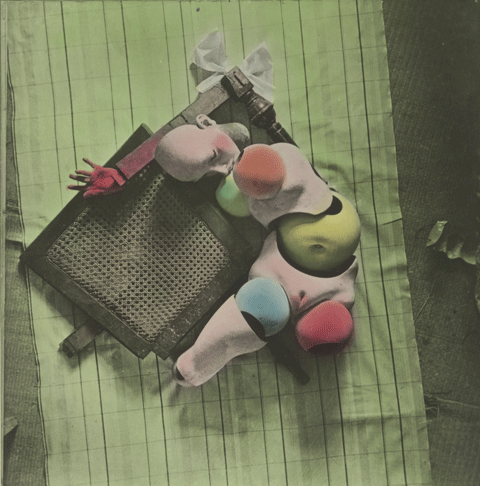
'POUPÉE ATOP BROKEN WICKER CHAIR' ca. 1935, by Hans Bellmer, gelatin silver print.
©Artists Rights Society (ARS), New York / ADAGP, Paris. |
Assembling outstanding, historically significant works of art does not necessarily make for an excellent exhibition. This is unfortunately true for “Under the Surface: Surrealist Photography,” on view at the Bowdoin College Museum of Art.
For this show, the Museum’s already impressive holdings of surrealist and modernist photography are augmented by loans from galleries and major institutions. As such, “Under the Surface” constitutes a rare opportunity to see a vital aspect of the art movement in depth. While writing was initially the favored medium for probing the human psyche, photography played an important supportive role that is evidenced by display copies of surrealist journals and magazines, many of them containing photographic images.
Photography is in fact often considered best suited to embodying surrealism’s basic principles. Its instantaneousness and purported minimal authorship presumably make it most responsive to the photographer’s and viewers’ subconscious desires; its close relationship to visible reality introduces levels of veracity and ubiquity not associated with any other visual medium.
Surrealists utilized photography to explore the invisible and unknowable in three basic ways: to capture found scenes of suggestive incongruity; to manipulate imagery in the darkroom; and to document actions of a surrealist bent, including oddly charged juxtapositions of objects. The majority of images in the exhibition are examples of these uses by the most acclaimed artists in the field, including Hans Bellmer, Claude Cahun, René Magritte, and Man Ray. Bellmer’s contorted, violated “dolls” are still hypnotic. In one of her best-known self-portraits, Cahun presents herself as a stylized symbol of femininity, a puppet of her own making. Magritte’s self-portrait, which substitutes one of his paintings for his torso, is both playful and meaningful. There’s also one of Ray’s early “rayographs.” The roster of artists rightly expands beyond the European circle to include the Americas. Among those, Juan Crisóstomo Méndez Ávalos’s fetishistic enactments are an intriguing discovery.
So why is this not an excellent show? Not for the art, but for the presentation and texts. While not distracting, the show’s grouping into traditional themes, such as still lifes and portraits, seems unnecessary and subtly undermines surrealists’ resistance to categorizing their own endeavors. And while some images certainly evoke an often raised suspicion of misogyny within the movement (such as André Kertész’s disturbing distortions of the female body that were commissioned by a “bawdy” magazine), only one object label makes a passing reference to this possibility by mentioning that women photographers chose female models as well.
A bigger problem is the conflation of surrealism — the early-20th-century radical art impulse — with surreal-looking images and those of later artists.
Berenice Abbott may serve as the example here. She did assist Ray in Paris but is hardly known as a surrealist. Her distorted self-portrait, for which she used a distortion easel she invented herself, was actually intended as an advertisement for the same. This undefined inclusiveness may inadvertently expose one of surrealism’s weaknesses and strengths at the same time, which remains largely unaddressed in the exhibition itself: over time, the surreal aesthetic became dislodged from its original, revolutionary intent, and appropriated as a purely formal idiom by visual makers from all walks of life, especially advertising.